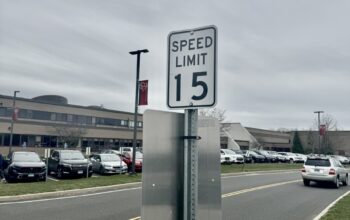Paige Skyrm
Reporter
@pskyrmcourant
When students think of junior year, the words stress, college and SATs often come to mind. For years, students have struggled to study for the SAT on top of their homework, sports and extracurriculars. That being said, in hopes of relieving some of the pressure, the Department of Education met at the beginning of the school year to reconfigure the junior testing requirements.

Why was the SAT brought in as the official state assessment?
While a good amount of testing is expected during junior year, students felt like all they were doing at the end of the school year was taking assessments. Often times, the Smarter Balanced assessments, or SBACs, were taken in the spring, which was around the same time students chose to take the SAT. With this pressure, it was difficult for students to balance their regular workload on top of these important tests. “We reached the conclusion that there was, in fact, too much testing in eleventh,” Governor Dannel P. Malloy said in an interview. “We thought it was just a tremendous amount of pressure concentrated in a single year.” Furthermore, the SBACs were taken over multiple days, which minimized class time for students who could have benefited from even one more math or english class.
In October, a decision was made by Governor Malloy along with the Department of Education to give the SAT as the official Connecticut state test. This legislative decision exempted the SBACs from the junior curriculum, hoping that it would make it easier for students to focus on their test preparation. Assistant Principal Larry Sullivan agrees with this idea. “The decision to bring in the SAT as the state assessment was designed to trim the testing time and to utilize an assessment that most students already chose to take so they can use the scores as part of the college application process,” he said.
How will offering the test through the school affect students?
Many believe that the March 2 test will be beneficial to students. It gives them an opportunity to take the test for free and choose whether or not they want to submit their scores. Moreover, for many students, this will be the first time they are taking the new SAT, giving them the opportunity to set a baseline score. SAT preparation is often stressful for students, but College and Career Center Coordinator Susan Carroll thinks that taking it at school will take away some of that heavy weight. “Taking the test in school should be beneficial to students as they are familiar with the environment,” she said.
Mr. Sullivan believes that taking the test through NCHS will benefit the school as well. “For NCHS and the state, these results will tell us what we are doing well and what we can do to improve our curriculum,” he said.

While many students and faculty believe that taking the SAT in school will be constructive, others disagree. Junior Ashley Tedford, a student who chose to take the ACT, believes that taking the SAT in school is unnecessary. “I understand that it will help those who have not started studying,” she said, “But I wish we could choose whether we take the ACT or the SAT.”
Important information about the test:
The SAT will be distributed to all juniors on Wednesday, March 2 in public schools across Connecticut. The test will begin at 7:30am, and students should come prepared with snacks, number two pencils and a calculator. The test itself is three hours, but students should expect it to last a total of four hours with preparation and breaks included. After the test, lunch will be offered from 11:30pm to 12:00pm, and periods 7, 8, and 5 will follow.
For more information, check out http://www.ncps-k12.org/site/default.aspx?PageType=3&DomainID=9&ModuleInstanceID=3042&ViewID=047E6BE3-6D87-4130-8424-D8E4E9ED6C2A&RenderLoc=0&FlexDataID=8419&PageID=11



